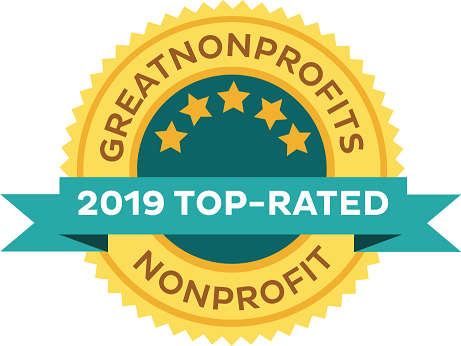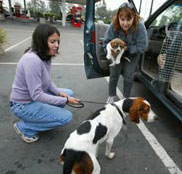



|
 |
Click here to see our
available rescue dogs
(Updated Daily!)
You can meet the rescue dogs at our weekend adoption events, or by appointment at the sanctuary.
Beagles and Buddies Sanctuary
23430 Hwy 18
Apple Valley, CA 92307
626-444-9664
Map: http://goo.gl/maps/n5Jiq
Email: beaglesandbuddies@gmail.com
|
B&B and 'Rescue Railroad" in the news!

 Dogs and cats get a second chance at life through a nationwide 'rescue railroad.' Dogs and cats get a second chance at life through a nationwide 'rescue railroad.'
By Jody Murray
The Fresno Bee
Gloriana Teixeira, left, hands over rescue dogs to Dana Crittenden, a board member of Noah's Friends Animal Sanctuary near Orange Cove.
Mark Crosse / The Fresno Bee
ANIMAL RESCUE ON THE WEB
California Rescue Railroad: A message board where rescuers set up transportation routes in the Western states.
The van glides off southbound Freeway 99, onto Herndon Avenue and into the Taco Bell parking lot. It pulls alongside a Chevy Venture with a license plate that reads K9MOM2.
Gloriana Teixeira gets out of the van and pops the rear hatch. Seconds later, a bright-eyed coon hound named Reuben bounds onto the asphalt. With one hand wrapped in Reuben's leash, Teixeira passes some papers to Kay Nelson, one of two women who arrived in the Venture.
Minutes later, the two vans leave the parking lot and return to the freeway, heading in opposite directions. Reuben, along with a smaller, wiry hound named Annie, rolls south inside the Venture.
Their journey to a private shelter in Los Angeles continues, thanks to a grass-roots system of animal transport that participants call the rescue railroad. The whistle stops are rest areas, gas stations or fast-food restaurants. The tracks are highways. The engines are volunteers who arrange and drive the legs of a transport relay.
The rescue railroad broadens the reach of the animal-rescue community (dogs and cats are the dominant cargo, but birds, reptiles and other pets also have been transported). It allows adopted animals to be delivered to new owners hundreds of miles away, or gives animals facing euthanasia at a county shelter a second chance at a private shelter.
Nelson, who owns and operates Noah's Friends Animal Sanctuary near Orange Cove, figures she averages three to four rescue-railroad legs a week. She also figures that, with or without her, a transport relay drives through the central San Joaquin Valley at least once a day.
On this overcast December afternoon, Nelson and the Venture's owner, Dana Crittenden, are serving as the second leg of a transport that began at Merced County Animal Control, where Teixeira serves as a volunteer. Annie and Reuben are heading to Beagles and Buddies, a rescue shelter in El Monte. Nelson plans to drive them there, but not immediately; she'll keep them at Noah's Friends until the wet weather subsides.
"We fight over the dogs because we want to keep all of them," Nelson jokes. Actually, housing animals is a constant chess game for rescuers, whose shelters are always at or beyond capacity. They often depend on "foster parents" such as Crittenden. Animals can stay in foster homes until a permanent owner can be found.
Crittenden bought the van a couple of years ago so she would have more room to transport animals. In addition to the license plate, letters in white script on the rear-hatch window spell out "Dog Mom Van." Crittenden, a Fresno County sheriff's deputy, also works closely with Nelson's shelter and serves as a foster mom for dogs.
At the Taco Bell rendezvous, Crittenden cradles an Akita puppy who was found in a Fresno County neighborhood with severe burns to his lip and jaw. A veterinarian said he probably chomped on a live electrical wire. Crittenden, who is taking care of the Akita until he heals, gave him a high-voltage name: Spike.
"This rescue railroad is just the thing," Crittenden says, "because it can get dogs to rescues that specialize [in the breed]." Beagles and Buddies, for instance, attracts potential owners looking for hounds such as Annie and Reuben.
Like many private animal-rescue operations, Nelson's shelter is always full. But she always finds room for a dog that needs a home for a few days, waiting for a foster home to open up or a new owner to appear.
"You find the energy in the success stories. That's what keeps us going, because there are so many things that can take us to our knees," Nelson says.
Transport networks for animals stretch across the United States and Canada. Animal advocates set up routes via phone calls, e-mail and Internet message boards.
On the West Coast, one network system calls itself California Rescue Railroad. Its flagship is a Yahoo! Groups message board on which members post transport plans. Other members help fill legs on the trip until the route is complete.
A recent example: On Dec. 13, a member posted that help was needed to transport an Anatolian shepherd named Kaylee from a foster home in Roy, Wash., to permanent owners in Winchester, a hamlet southwest of Hemet in Riverside County. The 1,170-mile trip was sliced into 11 legs over two days.
On Dec. 15, Tom Hamilton, transportation coordinator for the National Anatolian Shepherd Rescue Network, posted a message saying all but two legs were filled. On. Dec. 17, he announced the relay was complete.
"Kaylee is headed to her new home this weekend!" he wrote. "Thanks to all who cross-posted our requests, the list owners for providing us with these valuable forums, and most of all the drivers who are giving up their time and travel expense to get this girl through."
Hamilton, who lives in Sierra Vista, Ariz., became involved in animal transport about three years ago. Since then, he has coordinated about 75 rescue runs criss-crossing the United States.
"There are several 'black holes' in various parts of the country," he says. "It is incredibly difficult to fill a run in Kansas and in certain parts of Texas.
"I think getting the word out that these railroads exist is the most important thing. I believe there are many people out there who would be willing to help if they knew they were needed."
When an animal is being brought to a new owner, a rescue group geographically near the owner will conduct an interview and screening to ensure the dog or cat is going to a suitable home. The rescuers usually will make follow-up visits to check on the animal.
"The rescue groups deserve great accolades," says Sherry Meddick, who posts frequently on the California Rescue Railroad message board and makes transport runs at least once a week from her Orange County home. "Without them, I'd be driving in circles."
Rescue railroads also come to the doors of county animal-control shelters, which are required by law to take in every animal brought to them. Dogs and cats facing euthanization if they stay at the shelter too long are shipped out to so-called no-kill shelters, foster homes or permanent owners.
"The concept is phenomenal for our benefit and for the benefit of our animals," says Kirstin Gross, director of the Madera County Animal Shelter. "They give us a tremendous boost in saving lives."
When Gross took the top job at the Madera County shelter two years ago, the facility euthanized about 95% of the animals that came through its doors, she says. In November, the rate was 32%, she says.
"Our objective is to get as many out the door and in homes as we can. ... The rescue railroad is like Christmas every day they come."
|
|



















